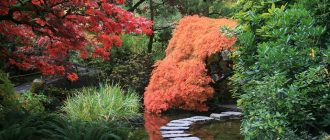Interested in knowing what constitutes the wonderful Japanese flower garden? Read on to find out…
A Japanese flower garden can be quite an astonishing work of art if it is composed along the right lines. The concept has long existed as part of Japanese tradition of garden design but is gaining currency in contemporary times. The idea is to keep it simple and try and replicate nature in your own space.
Many people have developed a liking for the Japanese flower garden. Their passion to have one in their homes has led them to experiment with the art form themselves. Not everyone can become a Pablo Picasso at Japanese style gardening but if you work along the right lines you too can end up with something special.
For most Non-Japanese people the real test is working with Asian plants. Since English gardens are strikingly different from oriental ones not only is the selection of plants completely different from what you normally find in European style gardens, the way they are arranged and the composing of the over all garden space is also poles apart.
Japanese Hill & Pond Gardens
There are a multitude of styles that fall under the umbrella of Japanese flower gardens. The hill and pond garden is one of the all time classics that can bring about awe inspiring results.
When it comes to the laying out aspect of Asian plants they are spread over in distinct areas. These areas are divided according to the size of the trees for instance there are the smaller flowering trees that have their own area whereas the shrubs are planted in another designated area usually in the foreground.
Then you have a specific place for a pond and hills. The background layer is formed by forest trees. The plants that form the foreground are given a deliberate rounded pruning. This is done in order to make them look like clouds and hills.
Japanese Plants
The Japanese flower garden consists of a variety of plantations. Evergreens are commonly featured in these works of art. For the Japanese artists evergreen trees take on a symbolic meaning of permanence. The sparse and strategic placement of plants is the essence of designing an ideal flower garden.
The idea behind limited use of plants is to create a focal point. By not overloading the garden with plantations the visitor is better able to focus and appreciate the carefully selected line of plants and their artistic placement. Amongst the most commonly featured evergreen trees in Japanese flower gardens are the Cedar, Canadian hemlock, Coastal redwood, Japanese black pine and the Himalayan white pine.
There are certain trees like the Scarlet maple, willow and the tulip tree that are used to decorate the area around the pond. It is not just the aesthetic appeal that these plants have when positioned near the pond which is the reason for them to be there rather these are the kind of plants that require a constant water supply which they get from the pond.
The Japanese flower garden is not complete without its hedges. Specially trimmed Japanese barberry, Weigla and the Yew can work wonders for the Japanese flower garden. With regards to the actual flowers that you would want to use the list includes Japanese maples, irises, tree peonies, azaleas and other oriental breeds.




